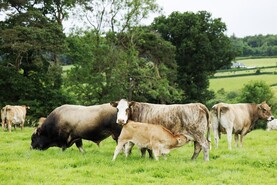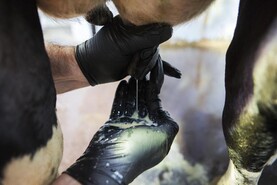The word change is overused in the world of politics, particularly by those in opposition and seeking power, but it is part of everyday life, including Irish agriculture.
It is defined by the Oxford dictionary as “an act or process through which something becomes different”.
This definition perfectly describes the Irish beef industry as we approach the end of the first quarter of the twenty first century.
Beef production in Ireland accelerated in the 1980s following the introduction of milk quotas to curb EU dairy production. The industry expanded on farm and downstream processing, aided by what in hindsight were generous Government and EU supports.
The most efficient model was to produce as big as possible as cheaply as possible, which meant that the processing sector revolved around cattle coming off grass.
Factories processed the cattle and sold the product to either the EU intervention system or third country markets with the assistance of EU subsidy payments. Commercial markets, primarily in the UK were the third market priority.
Market focus
Over time, the EU withdrew from both buying beef directly through intervention and supporting third country sales and the industry had to find customers.
This heralded a move to year round beef and the building of strong commercial relationships between Irish factories and retail food service customers, primarily in the UK but also across Europe.
This meant specifications as supermarkets wanted every roast and pack of steaks to look the same.
The expansion of the dairy herd and parallel decline of the suckler herd over the past decade is the catalyst for further change.
More recently the move by the Netherlands to restrict calf imports means that the Irish beef processing industry has to adapt to a changing supply base.
The next challenge is how to turn what has been an unwanted, almost by product from the Irish dairy herd into something that can be useful for the beef industry as it faces declining supplies of traditional suckler origin beef.
Integrated models
The open day at the Teagasc, Dawn Meats and Shinagh Estates joint venture in Co Tipperary this week is the latest demonstration of how calves from the dairy herd can be successfully incorporated into beef production.
Variations of this model are well established and the Farmers Journal Thrive dairy calf to beef farm demonstrated how it could work over several seasons.
Other processors have also been active with Kepak having a partnership established with Tirlan and the ABP Blade Farming is one of the earlier models of rearing calves to beef.
These are all much more integrated models compared with the traditional suckler model where weanlings were sold in marts and bought by finishers in an ad hoc manner.
The calf to beef models all follow a particular blueprint designed to produce a uniform product at the end of the cycle. Alongside this production model has been an increased focus on genetics.
The increased use of sexed semen has meant a huge drop in numbers of Friesian male calves with a low beef value and an increasing use of bulls on dairy cows that bring useful beef characteristics into the calf.
Comment
The Irish beef processing industry has been built by visionary entrepreneurs that maximised the support systems available from the Government and the EU to process abundant supplies of relatively cheap high quality beef produced by Irish farmers.
That supply stream has been under threat for some time as dairy farming has been a more profitable enterprise and expanded accordingly when the opportunity arose.
The next challenge for Irish processors is to develop a supply stream from the dairy herd and indications are that this is well under way.
Getting farmer buy in depends on it delivering profitability at the farm gate and demo farms can demonstrate what can be achieved.
Read more
Beef farmers need to demand CBV when buying dairy beef calves - Dillon
Tipperary dairy calf-to-beef farm targets €100,000 profit
The word change is overused in the world of politics, particularly by those in opposition and seeking power, but it is part of everyday life, including Irish agriculture.
It is defined by the Oxford dictionary as “an act or process through which something becomes different”.
This definition perfectly describes the Irish beef industry as we approach the end of the first quarter of the twenty first century.
Beef production in Ireland accelerated in the 1980s following the introduction of milk quotas to curb EU dairy production. The industry expanded on farm and downstream processing, aided by what in hindsight were generous Government and EU supports.
The most efficient model was to produce as big as possible as cheaply as possible, which meant that the processing sector revolved around cattle coming off grass.
Factories processed the cattle and sold the product to either the EU intervention system or third country markets with the assistance of EU subsidy payments. Commercial markets, primarily in the UK were the third market priority.
Market focus
Over time, the EU withdrew from both buying beef directly through intervention and supporting third country sales and the industry had to find customers.
This heralded a move to year round beef and the building of strong commercial relationships between Irish factories and retail food service customers, primarily in the UK but also across Europe.
This meant specifications as supermarkets wanted every roast and pack of steaks to look the same.
The expansion of the dairy herd and parallel decline of the suckler herd over the past decade is the catalyst for further change.
More recently the move by the Netherlands to restrict calf imports means that the Irish beef processing industry has to adapt to a changing supply base.
The next challenge is how to turn what has been an unwanted, almost by product from the Irish dairy herd into something that can be useful for the beef industry as it faces declining supplies of traditional suckler origin beef.
Integrated models
The open day at the Teagasc, Dawn Meats and Shinagh Estates joint venture in Co Tipperary this week is the latest demonstration of how calves from the dairy herd can be successfully incorporated into beef production.
Variations of this model are well established and the Farmers Journal Thrive dairy calf to beef farm demonstrated how it could work over several seasons.
Other processors have also been active with Kepak having a partnership established with Tirlan and the ABP Blade Farming is one of the earlier models of rearing calves to beef.
These are all much more integrated models compared with the traditional suckler model where weanlings were sold in marts and bought by finishers in an ad hoc manner.
The calf to beef models all follow a particular blueprint designed to produce a uniform product at the end of the cycle. Alongside this production model has been an increased focus on genetics.
The increased use of sexed semen has meant a huge drop in numbers of Friesian male calves with a low beef value and an increasing use of bulls on dairy cows that bring useful beef characteristics into the calf.
Comment
The Irish beef processing industry has been built by visionary entrepreneurs that maximised the support systems available from the Government and the EU to process abundant supplies of relatively cheap high quality beef produced by Irish farmers.
That supply stream has been under threat for some time as dairy farming has been a more profitable enterprise and expanded accordingly when the opportunity arose.
The next challenge for Irish processors is to develop a supply stream from the dairy herd and indications are that this is well under way.
Getting farmer buy in depends on it delivering profitability at the farm gate and demo farms can demonstrate what can be achieved.
Read more
Beef farmers need to demand CBV when buying dairy beef calves - Dillon
Tipperary dairy calf-to-beef farm targets €100,000 profit






 This is a subscriber-only article
This is a subscriber-only article










SHARING OPTIONS: